Archive for newspapers
American journalism contribution: Joseph Pulitzer
Posted by: nrodrigo | April 19, 2016 | No Comment |When one thinks of Benjamin Franklin it is difficult to think of him outside the political spectrum. One of the founding fathers of the United States, he contributed much to the Americas in a variety of ways.
What some people may not know is that Franklin was more than just a diplomat; he was an author and printer as well. Outside of organizing the first successful American lending library, he and Hugh Meredith purchased the Pennsylvania Gazette from a former boss in 1729.
Under the new ownership of Franklin and Meredith, the Pennsylvania Gazette quickly went from a struggling newspaper to the most read and successful among the colonies. The newspaper itself contained many stories revolving around lifestyle and issues of the colonial times.
The newspaper would also publish full texts of important political documents of the time such as the Declaration of Independence, the Constitution, Letters from a Farmer, Thomas Payne’s Common Sense, The Federalist Papers and many more.
Outside o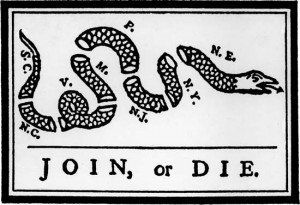 f ownership, Franklin would regularly contribute to the paper under aliases. One big contribution the Pennsylvania Gazette provided to journalism was the birth of the first American political cartoon. Entitled “Join or Die”, the political cartoon highlighted Franklin’s view of the fragmented state of the colonies and pushed the idea of unity among the colonies.
f ownership, Franklin would regularly contribute to the paper under aliases. One big contribution the Pennsylvania Gazette provided to journalism was the birth of the first American political cartoon. Entitled “Join or Die”, the political cartoon highlighted Franklin’s view of the fragmented state of the colonies and pushed the idea of unity among the colonies.
Tags: Benjamin Franklin, hugh meredith, Newspaper, nrodrigo, Pennsylvania Gazette, Political cartoon
Ida B. Wells was a prolific activist and muckracker who used her journalistic abilities to expose the brutal lynchings of African Americans in Memphis, Tennessee that were tragically common in the late 1890s.
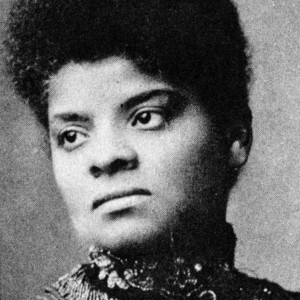 Living in a segregated, post-slavery society, Wells experienced discrimination herself that inspired her to write about the struggles of African Americans at the time. She taught in an all black school and was a vocal advocate for the improvement of their conditions. While teaching she also served as a journalist and publisher of the papers Memphis Free Speech and Highlight and Free Speech, both of which she owned.
Living in a segregated, post-slavery society, Wells experienced discrimination herself that inspired her to write about the struggles of African Americans at the time. She taught in an all black school and was a vocal advocate for the improvement of their conditions. While teaching she also served as a journalist and publisher of the papers Memphis Free Speech and Highlight and Free Speech, both of which she owned.
After a well respected and accomplished businessman in Memphis was taken from prison and murdered in a lynch mob for defending his store from white vandals, Wells took up the anti-lynching. She published articles in her own papers and others across the south. She even traveled to England to expose the horrors of lynching to the rest of the world through her writing and speaking.
Back in the States, Wells published an investigative piece on lynching in the New York Age, reaching audiences outside of the south. Wells went on to publish a book called A Red Record, which served as a compilation of all her writings and investigations on the topic. As the founder of the of the National Association of Colored Women, she led a crusade to reform the treatment of African Americans, specifically with regard to lynching and other forms of brutality, to President McKinley.
Wells died in 1931 but left behind a legacy of newspapers, pamphlets, books and articles that utilized the printed word and the art of muckracking to enact social change in her community and throughout the country.
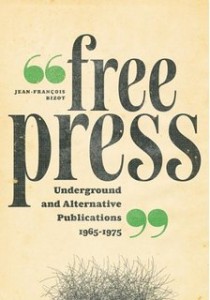 In the wake of the countercultural sentiments of the 1960s, a group of local papers whose objective was to give new ideas a voice in print formed a network known as the Underground Press Syndicate, or UPS.
In the wake of the countercultural sentiments of the 1960s, a group of local papers whose objective was to give new ideas a voice in print formed a network known as the Underground Press Syndicate, or UPS.
The organization represented an effort to unite even the smallest and newest of papers to freely publish their thoughts and ideas, and gave writers a network to use in order to educate themselves and the masses on the issues of the day in an open setting. Papers included in the UPS spanned the country and notably included The Fifth Estate, The Berkeley Barb, The Rag, East Village Other, and the Los Angeles Free Press.
UPS sponsored conferences throughout the country and encouraged the exchange of ideas among its members at such events. Criteria for membership simply included allowing other UPS members to reprint content, have access to subscriptions of an individual publication, and listing the contact information of other UPS members in their paper.
Publications included in the UPS focused on a wide variety of social issues and made a special effort to include support for the women’s liberation movement as it grew throughout the decade. Although these papers were clearly driven by opinion and diversity of thought as opposed to straight reporting, the network of contact information and reprinting agreements mirrors that of a wire service but for smaller, more dogmatic papers. According to historian Abe Peck, the UPS and the rise of the alternative press in conjunction to counterculture itself “represent[s] the participatory democracy, community organizing and synthesis of politics and culture that the New Left of the midsixties was trying to develop.”
The Washington Post released an article called “Sweet and Sour” by Marta Zaranska this week that was quite interesting, to say the least.
The article described a plethora of research and increase in studying a potential psychological-olfactory correlation. According to the article, in essence, mood and taste buds are linked. According to studies, your mood can influence things such as how sweet the water is that you are tasting.
… And this is just the beginning.
Not only can mood influence the things we taste,but the things we taste can also influence our mood and perceptions about our environment around us. The results have shown that ingesting sweets has the potential to “make you feel more romantic” and a 2013 experiment found that just thinking of love can even make plain water “taste sweeter”.
Nancy Dess, a professor of psychology at Occidental College in Los Angeles performed a study on bitter sensitive rats. Her findings found that those that showed a higher aversion to bitterness were also “more jumpy” then regular rats and showed hire indicators of stress than others. in addition, they also showed higher levels of social subordination.
In addition, a propensity towards certain tastes can tell a lot about an individual’s personality type. The article describes how individuals who are typically more sensitive to bitter taste are not only more easily disgusted than others but also have a tendency to be more emotional “…after watchingand anger and do you think video then other people”.
A 2014 study conducted by German and American psychologist showed that bitter-sensitive individuals were much more likely to be “jumpy” and react more strongly when exposed to loud noises.according to science, this makes sense. Naturally bitterness tells us that a food could potential he contain toxins and is an indicator of danger. So, it is therefore logical to find that bitter sensitive individuals would also have a higher level of sensitivity to other cues of dangerin other aspects of life.
Furthermore, The author went on to state that people who enjoyed foods with more bitter notes in them (i.e. tonic water, radishes)we’re more inclined than others to admit that they “enjoyed tormenting people or that they tend to manipulate others to get their way”.
Does your significant other tend to enjoy a nice, wholesome grapefruit every morning for breakfast? Be careful–Because if they do, they’re probably a sociopath..
Tags: Comm 445, Danni Holland, Experiment, Journalism, Mood, Psychology, Study, Taste, Washington Post
If the Beatles have a song named for it, it must be important. I’m talking, of course, about the British music newspaper turned magazine and blog, the New Musical Express (or NME). The music newspaper launched in 1949 in standard newsprint format, and was the first to publish its own singles chart that tracked the climate of music in the UK based on record sales.
The publication has documented the many trends and bands coming out of England for the past 60 years. From psych rock and the rise of the Beatles and the Rolling Stones in the 60s to the punks of the 80s and the chaotic Madchester scene of the 90s, NME covered the most ground on anything going on in the music world. In a country known for producing some of the finest music in the past decade, music fanatics and casual listeners alike could rely on the paper for comprehensive charts and entertaining coverage.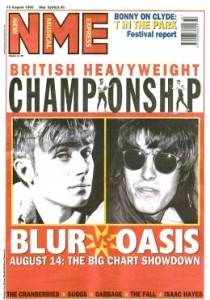
And when musicians from the US started to dominated the airwaves, NME jumped o
n that too, covering the likes of Nirvana. The rise of indie rock again in the early 2000s gave writers lots of new content. The internet allowed them to reach new audiences with online publication of articles but sales still dipped. NME.com saw success and won several awards for its online coverage.
The publication is responsible for informing the masses about indie music throughout many decades. Some have criticized the publication’s one sidedness when it comes to covering only certain genres. But borne of that was calling music that sounds like NME would cover it, well, NME. If a publication’s lasting impression is the coining of its own genre, I would say they’ve weathered the storm of change within the world of music journalism.
Recently I read on of the best articles I’d read in a while. Part feature, part investigative it’s a Washington Post article called ‘A Marine’s Convictions’ written by reporter John Woodrow Cox. It chronicles Marine Maj Mark Thompson, who was accused of sleeping with two students while a teacher at the Naval Acadamy– an offense that could result in being barred from the service. It asks the question — Is he innocent?
Using a refined attentional to detail, visceral descriptions and the reinforcement of audio Cox told the story so eloquently and grippingly that I went and read a bulk more of his articles.

The first and second place winner in 2014 for a Society for Features Journalism’s Short Feature award and finalist for Scripps Howard’s Ernie Pyle Award for Human Interest Storytelling, he is easily one of the best storytellers in the industry.
With 2,147 Twitter followers, why isn’t he more of a celebrity? Why do people opt to tweet and retweet what Anderson Cooper(7.32M followers) says and not a phenomenal writer like John Woodrow Cox?
It largely has to do with our society, how we create celebrities, and most importantly — reach.
Correspondents developed because publishers wanted to tell the news of abroad. There simply wasn’t a need for correspondents with spoken word — the people were the correspondents. With the development of the printing press and moveable type, information was able to spread vastly, feeding the appetite for news. Correspondents expanded the news and helped to deliver the news at a faster pace.
Anderson Cooper, works in the same sense. He has a farther reach and therefore, is able to spread the news and satisfy the need for news to more people. He aids in helping people to feel ‘in the loop’ because if they are watching it, more likely than not, a friend is watching it as well. Why does that matter? Because there is an intense need to be informed and ‘ready’ for discussion. A celebrity correspondent is a part of that culture of need.
If you’re able to reach the masses and ‘connect’ with them, you gain celebrity, regardless often times of talent or precision. This is a concept that Michael Steven’s addresses in his book at length.
The question is, what’s more important? The correspondent delivering the news or the news itself?
-J.
Around the world and in the madhouse with Nellie Bly
Posted by: mkkoszycki | March 15, 2016 | No Comment |Nellie Bly was an American journalist known best for writing an in depth expose on abuses taking place in an asylum. While writing this piece, Bly went undercover as a resident to better under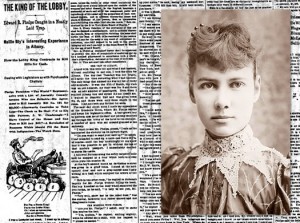 stand the inner workings of her subject. Her consummate approach to storytelling earned her a name among the ranks of famous muckrakers of her day. To this day Bly is celebrated for her journalistic achievements.
stand the inner workings of her subject. Her consummate approach to storytelling earned her a name among the ranks of famous muckrakers of her day. To this day Bly is celebrated for her journalistic achievements.
Her pioneering career began while struggling to find work as a young teacher in Pittsburgh. She wrote a letter to the Pittsburgh Dispatch expressing her displeasure with their coverage of working women, admonishing the author for their narrow mindedness and shedding light on the challenges women of her time faced. Impressed by her passion and craft, the paper hired her.
By 1887, Bly began writing for the New York World. She was given the assignment of covering the conditions of a notorious home for the mentally ill in New York state. Rather than observe its residents or conduct interviews with staff, Bly posed as a patient and entered the asylum for ten days. Her story got the attention of many in the community and actually created social change among lawmakers and locals who saw the mistreatment of those institutionalized at the center.
Bly also made a name for herself by traveling around the world on a solo journey in just 80 days. This trip brought her even more fame, and she went on to write a book about her travels. Whether Bly used her experiences to give others a voice, went undercover or staged a great adventures, she holds a place among the world’s best journalists and one of the original muckrackers of her time.


 above the fold
above the fold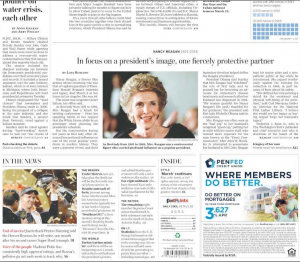


 d to report.
d to report.